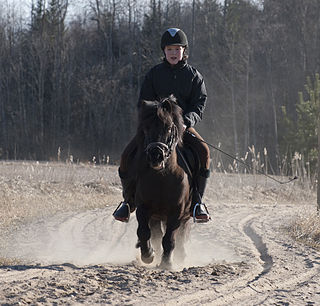
The Shetland pony is a Scottish breed of pony originating in the Shetland Islands in the north of Scotland. It may stand up to 107 cm (42 in) at the withers. It has a heavy coat and short legs, is strong for its size, and is used for riding, driving, and pack purposes.

Exmoor is loosely defined as an area of hilly open moorland in west Somerset and north Devon in South West England. It is named after the River Exe, the source of which is situated in the centre of the area, two miles north-west of Simonsbath. Exmoor is more precisely defined as the area of the former ancient royal hunting forest, also called Exmoor, which was officially surveyed 1815–1818 as 18,810 acres (7,610 ha) in extent. The moor has given its name to a National Park, which includes the Brendon Hills, the East Lyn Valley, the Vale of Porlock and 55 km (34 mi) of the Bristol Channel coast. The total area of the Exmoor National Park is 692.8 km2 (267.5 sq mi), of which 71% is in Somerset and 29% in Devon.

Moorland or moor is a type of habitat found in upland areas in temperate grasslands, savannas, and shrublands and montane grasslands and shrublands biomes, characterised by low-growing vegetation on acidic soils. Moorland, nowadays, generally means uncultivated hill land, but also includes low-lying wetlands. It is closely related to heath, although experts disagree on what precisely distinguishes these types of vegetation. Generally, moor refers to highland and high rainfall zones, whereas heath refers to lowland zones which are more likely to be the result of human activity. Moorland habitats mostly occur in tropical Africa, northern and western Europe, and neotropical South America. Most of the world's moorlands are diverse ecosystems. In the extensive moorlands of the tropics, biodiversity can be extremely high. Moorland also bears a relationship to tundra, appearing as the tundra and the natural tree zone. The boundary between tundra and moorland constantly shifts with climatic change.

The Eriskay Pony is a breed of pony from Scotland. It is generally grey in colour, and has a dense, waterproof coat that protects it in harsh weather. The breed developed in ancient times in the Hebrides of Scotland, and a small population remained pure and protected from crossbreeding by the remoteness of the islands. It is used for light draught work, as a mount for children, in many equestrian disciplines, and for driving.
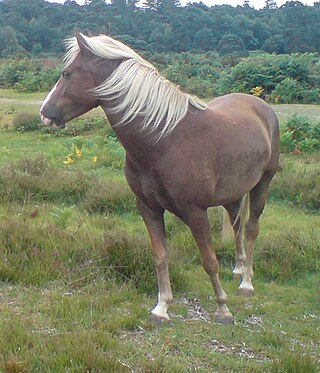
The New Forest pony is one of the recognised mountain and moorland or native pony breeds of the British Isles. Height varies from around 12 to 14.2 hands ; ponies of all heights should be strong, workmanlike, and of a good riding type. They are valued for hardiness, strength, and sure-footedness.

The Dartmoor National Park Authority (DNPA) is a national park authority in England, legally responsible for Dartmoor in Devon. It came into existence in its present form in 1997, being preceded by a committee of Devon County Council and the Dartmoor National Park Committee from 1 April 1974.

The Canadian is a horse breed from Canada. It is a strong, well-muscled horse, usually dark in colour. It is generally used for riding and driving. Descended from draft and light riding horses imported to Canada in the late 1600s from France, it was later crossed with other British and American breeds. During the 18th century the Canadian horse spread throughout the northeastern US, where it contributed to the development of several horse breeds. During the peak popularity of the breed, three subtypes could be distinguished, a draft horse type, a trotting type and a pacing type. Thousands of horses were exported in the 19th century, many of whom were subsequently killed while acting as cavalry horses in the American Civil War. These exports decreased the purebred Canadian population almost to the point of extinction, prompting the formation of a studbook and the passage of a law against further export.

The Dales Pony is a British breed of pony or small horse. It originated in, and is named for, the Dales of Yorkshire in northern England. It is one the nine native mountain and moorland pony breeds of the United Kingdom, and belongs to the broader Celtic group of ponies which extends from Portugal and northern Spain to Scandinavia.

The Exmoor Pony is a British breed of pony or small horse. It is one of the mountain and moorland pony breeds native to the British Isles, and so falls within the larger Celtic group of European ponies. It originates on, and is named for, the Exmoor area of moorland in north-eastern Devon and western Somerset, in south-west England, and is well adapted to the climate conditions and poor grazing of the moor. Some still live there in a near-feral state, but most are in private ownership.
Riding pony is a horse show classification used to refer to certain types of ponies. Competition is divided into sections based on height and type, and include being judged under saddle in standard pleasure horse classes, as well as in related events such as sidesaddle or in-hand.

The Connemara pony is a pony breed originating in Ireland. They are known for their athleticism, versatility and good disposition. The breed makes excellent show ponies.
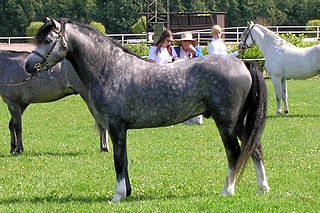
The Welsh Pony and Cob is a group of four closely-related horse breeds including both pony and cob types, which originated in Wales. The four sections within the breed society for the Welsh breeds are primarily distinguished by height, and also by variations in type: the smallest Welsh Mountain Pony ; the slightly taller but refined Welsh Pony of riding type popular as a children's show mount; the small but stocky Welsh Pony of Cob Type, popular for riding and competitive driving; and the tallest, the Welsh Cob, which can be ridden by adults. Welsh ponies and cobs in all sections are known for their good temperament, hardiness, and free-moving gaits.

The Fell pony is a versatile working breed of mountain and moorland pony originating on Cumberland and Westmorland farms of northwest England and is used for riding and driving. The breed is closely related to its geographic neighbour, the Dales Pony, but is a little smaller and more pony-like in build. The Fell Pony is noted for hardiness, agility, strength and sure-footedness.
The Welara is a part-Arabian pony breed developed from the Arabian horse and the Welsh pony. It was originally bred in England by Lady Wentworth at the Crabbet Arabian Stud in the early 1900s from imported Arabian stallions and Welsh pony mares. Breeding then spread throughout North America. In 1981, a breed registry was formed in the United States, and a studbook began to be published. They are used for many disciplines of English riding, and are known for their refinement, hardiness and spirit.
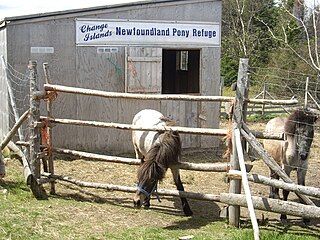
The Newfoundland pony is a breed of pony originating in Newfoundland, Canada. They are sturdy and muscular ponies, found in many colors, including the relatively rare white coloration. The Newfoundland developed from a mix of English, Irish and Scottish pony breeds brought to Newfoundland by settlers over a period of four centuries. Initially free-roaming, they crossbred to produce the modern type. They were used by settlers as draft and multi-purpose ponies until the mid-20th century, when they were brought almost to the point of extinction by mechanization and slaughter. The population rebounded slightly after the formation of a breed registry in 1980, but still remains low. In 1997, the Newfoundland pony was declared a heritage breed of Newfoundland and Labrador, which afforded it protection under the law, but the breed has not yet been recognized under the Canadian federal Animal Pedigree Act. As of 2008, there were 248 registered ponies of breeding age, out of a total population of 361. In 2013, the widely dispersed breeding population is still estimated at between 200 and 250 animals.

The Irish Draught horse is the national horse breed of Ireland which developed primarily for farm use. Today, they are especially popular for crossing with Thoroughbreds and warmbloods, producing the popular Irish Sport Horses which excel at the highest levels of eventing and show jumping.

The Australian Pony is a breed of pony that developed in Australia. It was greatly influenced by the native British breeds, especially the Welsh Pony, as well as some Arabian bloodlines.
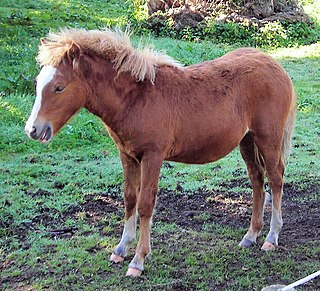
The Kerry Bog Pony is a mountain and moorland breed of pony that originated in Ireland. Possibly descended from the Irish Hobby horse, it originally lived a mainly feral existence in the peat bogs of what is now County Kerry in southwestern Ireland. Local inhabitants used the ponies as pack and cart horses for transporting peat and kelp to the villages. The breed developed physical characteristics including a low weight-to-height ratio and an unusual footfall pattern, which helped it move on soft ground such as peat bogs. The ponies were known for hardiness and an ability to survive in harsh conditions.

Mountain and moorland ponies form a group of several breeds of ponies and small horses native to the British Isles. Many of these breeds are derived from semi-feral ponies kept on moorland or heathland, and some of them still live in this way, as well as being kept as fully domesticated horses for riding, driving, and other draught work, or for horse showing.




















